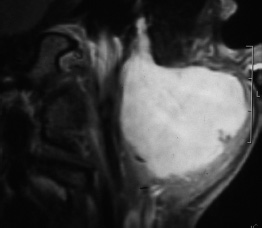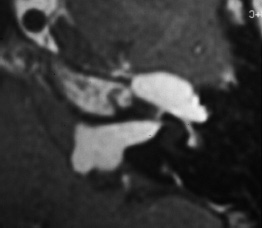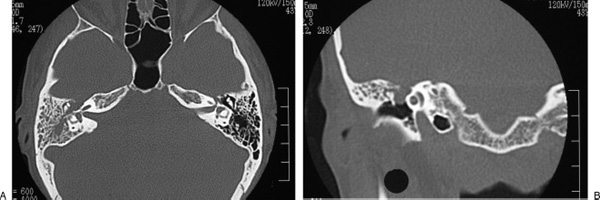24 Facial nerve schwannomas are benign, slow-growing, encapsulated neoplasms of nerve sheath origin that may involve any site along the course of the facial nerve. Even at large referral centers, only one to three new patients per year present with this disease entity. The diagnosis of the condition has proved challenging because of its rarity, variable clinical presentation, and slow progression of symptoms. Fortunately, neuroradiological imaging has greatly facilitated the accurate diagnosis of this lesion. ■ Classification of Facial Nerve Schwannomas Facial nerve schwannomas may arise at any location along the course of the nerve, from the cerebellopon-tine angle to its peripheral branches in the parotid gland. Based on their anatomical location and the personal experience of one of the authors (UF), facial nerve schwannomas have been classified as • Extratemporal facial nerve schwannomas • Intratemporal facial nerve schwannomas • with extratemporal extension • with intracranial extension • Intracranial cerebellopontine angle facial nerve schwannomas The majority of patients (~60-70%) have intratemporal tumors.1, 2 Typically, an intratemporal facial nerve schwannoma presents as a chain of pearls that involves the fallopian canal from the geniculate ganglion to the second genu and the mastoid segment of the nerve. An extension beyond the stylomastoid foramen into the parotid as well as a proximal extension into the labyrinthine segment is possible and should be carefully assessed.3 Schwannomas of the chorda tympani nerve4, 5 are rare. Pure extratemporal tumors may involve the main trunk of the facial nerve in the parotid gland or arise from a peripheral branch.6 Intracranial tumors are extremely rare, and preoperatively these are almost always diagnosed as vestibular schwannomas.1 They may even be considered as invasive vestibular schwannomas because, in our experience (UF), the eighth nerve may also be compromised at the time of tumor resection. ■ Clinical Symptoms and Diagnosis The mean age at diagnosis is under 40 years of age1,7,8 with a slight female predominance. In a recent review on the management of intratemporal facial nerve schwannomas from Korea, however, Kim et al8 presented two infants with progressive facial palsy a few weeks after birth, where the cause was a facial nerve schwannoma. The presenting symptoms and signs9 can be divided into three groups: symptoms of unilateral facial dysfunction, otologic symptoms, and symptoms due to the tumor mass. Intratemporal tumors often present with facial paresis (60-80%). Sometimes, however, there is only a mild facial dysfunction, which is so insidious in its progression that it may not alert the patient for many months to years before consultation is sought.10 The most typical manifestation is a slowly progressive palsy, although cases with sudden facial nerve paralysis mimicking Bell’s palsy have been encountered. Ipsilaterally recurrent, progressive or acute facial palsies without recovery over 3 to 6 months require further workup to exclude or diagnose a facial nerve tumor. Otologic signs of intratemporal tumors depend on the tumor size and location. Conductive hearing loss, aural fullness or tinnitus, and intermittent otorrhea may be signs of tumor involvement. On otoscopy a bulging mass from the posterior canal wall or a lateralized eardrum without signs of infection can often be identified. Some of these patients are misdiagnosed as having cholesteatomas, although their history and the clinical findings are not typical for a chronic infection. Mild sensorineural or mixed hearing losses have been described,8 but unless there is no extension into the internal auditory canal or into the cochlea, their cause remains unclear. Extratemporal facial nerve schwannomas most commonly present with parotid masses alone. Facial nerve palsies are either less severe, may involve only few branches of the nerve, or may not be present at all. In other instances the tumor may not be palpable but becomes visible on magnetic resonance imaging (MRI) during the workup of a progressive facial palsy. Intratemporal extension has to be excluded because these tumors may extend proximally into the stylomastoid foramen. The tumor then takes on a dumbbell appearance (Fig. 24–1). Intracranial tumors in our experience (five cases) had facial weakness at initial presentation and presented with sensorineural hearing losses, tinnitus, and vestibular dysfunction (three of five). They were diagnosed as vestibular schwannomas prior to surgery. FIGURE 24-1 Coronal magnetic resonance imaging of a large extratemporal tumor extending into the parotid gland and widening the stylomastoid foramen. Once the diagnosis has been suspected clinically, MRI with gadolinium and high-resolution computed tomography (HRCT) are mandatory to confirm the facial nerve tumor and its extent. On MRI the tumor shows enhancement along its entire course, with swelling of the nerve at various sites (Fig. 24–2). The MRI should always include both the temporal bone and the parotid, including the entire course of the facial nerve. One has to keep in mind that gadolinium enhancement within the labyrinthine and perigeniculate areas can be seen in many patients following Bell’s palsy even weeks to months after the acute paralysis (and subsequent recovery of facial function) and that areas of enhancement in the tympanic or mastoid segment of the nerve can be visualized in normal facial nerves.11 HRCT delineates bony erosion by the tumor with enlargement of the fallopian canal (Fig. 24–3A,B). Widening of the labyrinthine segment and the geniculate ganglion is an indirect sign of proximal extension of intratemporal tumors, and expansions at the stylomastoid foramen indicate distal extension. Once the diagnosis has been suspected clinically and further supported by radio-graphic studies, any biopsy of the tumor or even fine needle aspirations should be avoided. Attempts to biopsy a middle ear mass frequently lead to immediate facial nerve palsies or deteriorate preexisting facial dysfunction.12 Even if the tumor is encountered by surprise during middle ear or parotid surgery, no biopsy should be performed. Intraoperative stimulation of the tumor will provide immediate electromyographic (EMG) response of the facial nerve monitor (or active facial movements) and guide the surgeon to abandon the procedure until the neuroradiological workup has been completed and a treatment plan has been discussed with the patient. FIGURE 24-2 Axial magnetic resonance imaging of a facial nerve neuroma with tumor masses at the geniculate ganglion and within the internal auditory canal and cerebellopontine angle. Note the small labyrinthine segment between the tumor bulks. FIGURE 24-3 (A) Axial and (B) coronal computed tomographic scans of a right intratemporal facial neuroma with a tumor mass at the geniculate ganglion, displacing the ossicular chain, extending into the mastoid segment, widening the fallopian canal, and eroding the bony tegmen tympani. Electrodiagnostic tests [EMG, electroneurography (ENoG), brainstem audiometry] have been used to evaluate facial function but are unable to distinguish facial nerve tumors from other posterior fossa tumors. Topognostic testings are not used in our clinics because they have not proven to be of diagnostic or topognostic value. ■ Differential Diagnosis A range of rare lesions along the facial nerve need to be excluded as differential diagnosis. In the parotid region a variety of malignancies may induce facial palsy. Intratemporal tumors such as ossifying hemangiomas are typically located at the level of the geniculate ganglion.13–15 Temporal paragangliomas (arising at the jugular foramen), meningiomas, neurofibromas or middle ear adenomas,16 and metastatic lesions may present as tumor masses behind an intact drum with otologic symptoms and potential facial nerve dysfunctions. These lesions all enhance with a contrast-enhanced MRI scan. Supralabyrinthine cholesteatomas can also induce painless progressive facial nerve paralysis.17 With a careful history, clinical examination, and radiological workup, extratemporal and intratemporal facial nerve schwanno-mas can be diagnosed accurately. However, the diagnosis of intracranial facial nerve schwannomas remains difficult for the reasons already mentioned. ■ Management Several large series of cases of facial nerve schwannomas have been reported, and the initial concept of early tumor removal has been revised and a newer treatment algorithm has been adopted. One of the newer methods of management of these tumors is to excise the tumor and to preserve facial nerve fibers and facial function.18 This concept has not gained wide acceptance and in our opinion is not advisable. Therefore, any decision to remove the tumor necessitates grafting of the nerve and aims for a final facial function of a House-Brackmann (HB) grade III or Fisch score of 50 to 75% at best. It is important to keep in mind this outcome figure when deciding to remove a facial nerve schwannoma. Once surgical resection has been decided, intraoperative frozen section analysis of biopsies taken from within the tumor should usually confirm the proper diagnosis. Most patients with normal facial function cannot adequately estimate a permanent loss offacial function even if properly informed by their physician. Table 24–1 provides some guidelines in brief on managing facial nerve schwannomas. Depending on the location of the tumor, its extent, and the patient’s preoperative facial function, we advocate the treatment concept described in the following sections. Extratemporal Tumors
Tumors of the Facial Nerve



Stay updated, free articles. Join our Telegram channel

Full access? Get Clinical Tree


